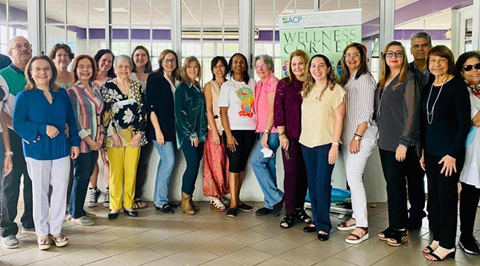WBCs in Their Community: Promoting Positive Working and Learning Environments

Puerto Rico WBC Melba Feliciano, MD, FACP, and her team in action. Check out photos from well-being activities at their chapter and in the community. Photo story here!
Loneliness & Belonging
By Kerri Palamara, MD, MACP
Apply tools to promote belonging and combat loneliness.
Loneliness and its positive counterpart belonging are an important area of focus in our learning and workplace environments. In health care, it is surprisingly common to be surrounded by people yet very alone. Our ability to establish habits or routines that foster belonging and connectedness is limited by the chaos and the uncertainty of our lives and schedules. As we get busier, we often miss out on social events, gatherings, and connectivity opportunities, and then find ourselves lacking the energy needed to reconnect once we become disconnected. In addition, due to habits we've developed for our own safety and the safety of others during the COVID-19 pandemic, we often work alone in offices with our doors shut, or in a work area masked having lost unique features of our personality and individuality.
What is the downside of loneliness? Loneliness and social isolation increase the risk for premature death as much as smoking up to 1.5 packs of cigarettes daily, and also increase risk for heart disease, stroke, dementia, anxiety, and depression.1 Surgeon General Vivek Murthy discusses this topic in detail and shares ways to combat loneliness and social isolation in his Advisory on the Healing Effects of Social Connection and Community.
What can you do as a Well-being Champion to combat loneliness and foster a sense of belonging? One way to help is to create space and opportunities for connection and conversation in your Chapter. Below are reflection questions that can get you started on this conversation. The goal of this approach is to help those in your chapter consider what relationships are most important to them, how they stay connected to those relationships and to others, and what their best strategies to combat loneliness might be. Therefore, don't worry about asking all of these questions.
If you are 1:1 or in small groups, focus first on opening the conversation; listen to understand and reflect to explore their answers. As you identify areas for further consideration, use the GROW model and your powerful what and how questions to guide the conversation. There is nowhere this conversation needs to go, so just go with their flow, and end with asking them what they will take away from the exercise.
If you are in a larger group setting, pose these questions for discussion, and allow participants in breakout rooms or in smaller groups to reflect together and share their thoughts. End with an opportunity to debrief and share in the larger group, and perhaps participants can come up with ideas of ways to stay connected to each other after the session.
- What are the most important relationships you have? Which relationships are you most grateful for? These could be individuals, groups, interests, communities.
- Where can you go and just be yourself?
- How connected do you feel to these relationships?
- What strategies help you stay connected? How could you do more of that?
- What does loneliness look and feel like for you? How about belonging?
- What activities or relationships are you currently engaged in that drain your energy and leave you feeling less connected? How could you use your time in ways that better support you?
- Is there an area of deeper connectedness or belonging you'd like to explore? Perhaps a hobby, new relationships, or comfort with being alone? What would that look like to work on? Where could you start?
- What did you learn from today? What's one thing you could take away from this conversation?
GROW Model for Coaching
G = Goal/Vision - What would it look like if this were going well? What is the ideal state we are working toward?
R = Reality - Where are things now? What is going well? What are potential challenges/greatest areas for improvement?
O = Options - What are the options to move forward from where you are now to where you want to be? What could you try to move toward your goal state? Try to consider at least 3 options.
W = Way forward - Of those options, which is the way forward you'd like to pursue? Where could you start? What commitments are you ready to make today?
Complement Resources:
- Build Connection with the GROW Model
- Learn How to Conduct a Listening Campaign
- 1. Our epidemic of loneliness and isolation: the US Surgeon General's advisory on the healing effects of social connection and community. 2 May 2023. U.S. Department of Health and Human Services. Accessed at www.hhs.gov/sites/default/files/surgeon-general-social-connection-advisory.pdf.
Oath to Self-Care and Well-Being
By Mukta Panda, MD; Kevin E. O’Brien, MD; and Margaret C. Lo, MD
While the Hippocratic Oath traditionally referred to the care for patients, this same language should extend to physician self-care as well.
Back to the July 21, 2023 issue of ACP IM Thriving

